What lies ahead
 Rajeev Sharma
Rajeev Sharma
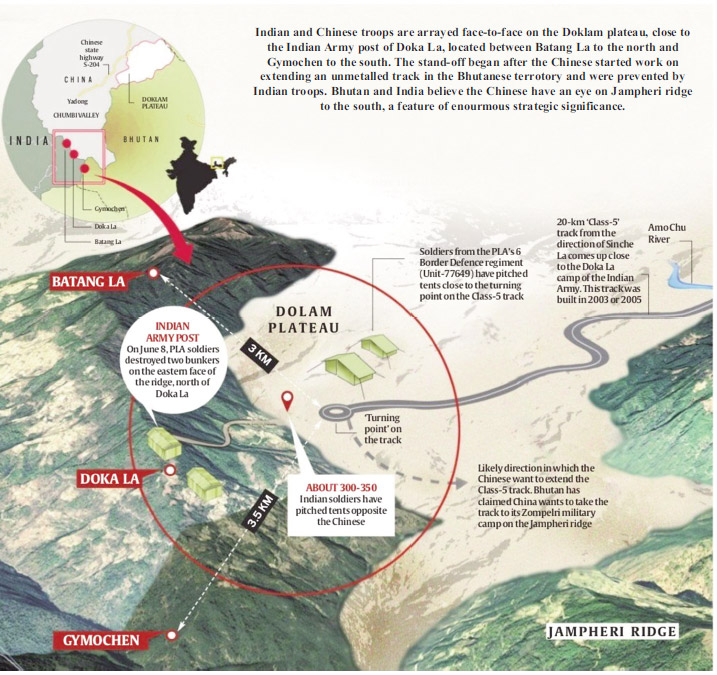 Illustrative diagram of the Doklam plateau at the India-China-Bhutan tri-junction in the Sikkim sector,
showing the relative positions of the Indian Army post at Doka La, the 20 km-long Chinese 'Class-5' track,
and the Jampheri ridge. The drawing is approximate, and not to scale. Sarfaraz Alam/Terrain Image from Google
Earth. Courtesy Indian Express
Let's come to the
brasstacks upfront.
China's shenanigans in
Doklam area have
wiped off in one stroke
whatever goodwill it
had tried to generate among Bhutanese for the last decade .
China has been wooing,
coaxing, even coercing Bhutan to
set up bilateral diplomatic ties
and Bhutan has been
withstanding the Chinese
enormous pressures all this
Illustrative diagram of the Doklam plateau at the India-China-Bhutan tri-junction in the Sikkim sector,
showing the relative positions of the Indian Army post at Doka La, the 20 km-long Chinese 'Class-5' track,
and the Jampheri ridge. The drawing is approximate, and not to scale. Sarfaraz Alam/Terrain Image from Google
Earth. Courtesy Indian Express
Let's come to the
brasstacks upfront.
China's shenanigans in
Doklam area have
wiped off in one stroke
whatever goodwill it
had tried to generate among Bhutanese for the last decade .
China has been wooing,
coaxing, even coercing Bhutan to
set up bilateral diplomatic ties
and Bhutan has been
withstanding the Chinese
enormous pressures all this
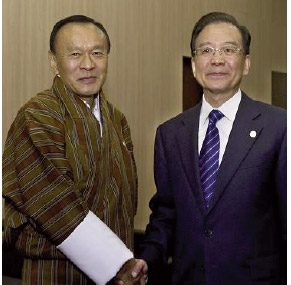 Former Chinese Premier Wen
Jiabao with his Bhutanese
counterpart Jigmi Y. Thinley in
Rio de Janeiro.
while. But after the unprovoked
and unwarranted Chinese
aggression in Doklam, Beijing
should forget about opening its embassy in Thimpu for many
years, a strategic objective of
China which appeared to deliver
dividends soon after the June
2012 meeting between Chinese
Premier Wen Jiabao held his first
meeting with Bhutanese Prime Minister Jigmi Y. Thinley primarily
on this issue in Rio de Janerio.
Former Chinese Premier Wen
Jiabao with his Bhutanese
counterpart Jigmi Y. Thinley in
Rio de Janeiro.
while. But after the unprovoked
and unwarranted Chinese
aggression in Doklam, Beijing
should forget about opening its embassy in Thimpu for many
years, a strategic objective of
China which appeared to deliver
dividends soon after the June
2012 meeting between Chinese
Premier Wen Jiabao held his first
meeting with Bhutanese Prime Minister Jigmi Y. Thinley primarily
on this issue in Rio de Janerio.
The month-long ongoing
India-China standoff in
Doklam at the Sikkim-
Bhutan-Tibet trijunction
is among the worst
crises between India
and China since the two
Asian giants fought a
war five and a half
decades ago – a crisis
where both sides are
sticking to their
respectively stated
maximalist positions
and asking each other
to back off but neither
side is doing what it is
asking the other to do.
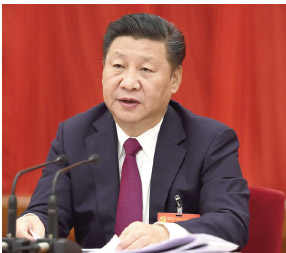 Xi Jinping
This is the most important self
goal that the Chinese have scored
with regard to their sustained
wooing of the tiny Bhutan. China
has behaved boorishly with this
aggressive action and has
alienated the common Bhutanese
to a large extent. Judged from this
specific context alone, India
should send a 'thank you' note to
the Chinese for doing what the
Indians had been trying to do all
these years: ensuring that China
does not establish direct
diplomatic relations with Bhutan.
The reason is simple. The
Doklam issue has got nothing to
do with the Sino-Indian border
dispute. Instead, it's all about a
China-Bhutan boundary problem.
India has waded into the frame
because it is treaty-bound to
protect Bhutan from all external
aggressions and the Doklam issue
must be seen in the correct perspective: that a giant country
is trying to threaten its tiny
neighbour.
Xi Jinping
This is the most important self
goal that the Chinese have scored
with regard to their sustained
wooing of the tiny Bhutan. China
has behaved boorishly with this
aggressive action and has
alienated the common Bhutanese
to a large extent. Judged from this
specific context alone, India
should send a 'thank you' note to
the Chinese for doing what the
Indians had been trying to do all
these years: ensuring that China
does not establish direct
diplomatic relations with Bhutan.
The reason is simple. The
Doklam issue has got nothing to
do with the Sino-Indian border
dispute. Instead, it's all about a
China-Bhutan boundary problem.
India has waded into the frame
because it is treaty-bound to
protect Bhutan from all external
aggressions and the Doklam issue
must be seen in the correct perspective: that a giant country
is trying to threaten its tiny
neighbour.
The month-long ongoing India-
China standoff in Doklam at the
Sikkim-Bhutan-Tibet trijunction is
among the worst crises between
India and China since the two
Asian giants fought a war five and
a half decades ago – a crisis
where both sides are sticking to
their respectively stated
maximalist positions and asking
each other to back off but
neither side is doing what it is asking the other to do.
It is queer that the Doklam
crisis erupted full bloom exactly a
month China held an
international event, the Belt and
Road Summit in Beijing on 14-15
May which India dismissively
boycotted. It's quite probable that
the Indian boycott of a summit on
China's biggest-ever project being
personally shepherded by none
other than President Xi Jinping
was the real trigger for the
Chinese action in Doklam. While
talking about the Doklam standoff
an important thing to be kept in
mind is that it is not about India-
Extraordinary situations
need extraordinary
solutions and out of the
box strategies, which the
current Doklam standoff
demands. The OBOR
card may well be the
best card to be played at
this juncture.
Trade diplomacy
China has pushed the envelope
on the Doklam issue at a wrong
time. By rolling out its ambitious
One Belt One Road (OBOR)
project, China has taken a giant
leap into a trade diplomacy while
promising huge economic returns
to all stakeholders, particularly its
neighbouring countries. With this
initiative, China has become a
'chatur baniya' or a clever
mercenary. And mercenaries
don't fight! They don't fight even
with fisticuffs, leave alone waging
wars. Therefore, China is in no
position to wage wars even
against tiny powers like Bhutan,
leave alone a mighty nucleararmed
neighbour like India.
So, if China is not in a position
to wage a war why is it prolonging
the Doklam crisis and why doesn't
it simply withdraw its troops?
That's a million dollar question
and there are no
credible answers from
China at this stage.
Obviously, China
has bitten much more
than it could chew
primarily because it
never anticipated that
the Indian response
would be so robust, so
prompt and so
categorical. Now faced
with this kind of
unexpected Indian
response, the Chinese are left to
justify their aggression in Bhutan
by hook or by crook. The Chinese
are now battling to keep intact
their image of a near-superpower
in the region. That explains why
the Doklam standoff has
stretched so long already and
may go on for quite some time
more.
Also, China knows in hearts of
its heart that it is not dealing with
India of 1962, despite the
diplomatic shrill from China that
India is not dealing with the China
of 1962. Whichever way you look
at it, the truth is that China is
finding itself caught in an ugly
situation. China is concerned that
if it were to pull out its troops
from Doklam now or in near
future, it would be emerging as a
weak power in eyes of its putative
regional satellites, something
which it can I'll afford. That's why
the Doklam crisis is continuing.
Flashpoints
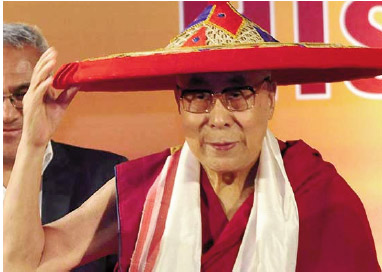 The Dalai Lama wearing an
Assamese Japi during an event
in Guwahati.
Forget the serial bilateral
flashpoints between India and
China like the Dalai Lama's fairly
long visit to Arunachal Pradesh,
China's opposition to India's aspirations for full membership
of the Nuclear Suppliers Group
(NSG) or China blocking India's
campaign on the issue of the
United Nations blacklisting
Pakistan-backed terrorists like
Masood Azhar. The real red flag in
Sino-Indian bilateral ties may well be the OBOR issue.
The Dalai Lama wearing an
Assamese Japi during an event
in Guwahati.
Forget the serial bilateral
flashpoints between India and
China like the Dalai Lama's fairly
long visit to Arunachal Pradesh,
China's opposition to India's aspirations for full membership
of the Nuclear Suppliers Group
(NSG) or China blocking India's
campaign on the issue of the
United Nations blacklisting
Pakistan-backed terrorists like
Masood Azhar. The real red flag in
Sino-Indian bilateral ties may well be the OBOR issue.
 Masood Azhar
FIndia has rejected OBOR
because its integral component is
the CPEC or China Pakistan
Economic Corridor, which passes
through Pakistan Occupied
Kashmir (PoK). China isn't moved one bit by Indian protests over
the CPEC and, obviously, the Modi
government can't be seen as
giving a green light to a project
that benefits arch rivals Pakistan
and compromises its stand on the
Kashmir issue.
Masood Azhar
FIndia has rejected OBOR
because its integral component is
the CPEC or China Pakistan
Economic Corridor, which passes
through Pakistan Occupied
Kashmir (PoK). China isn't moved one bit by Indian protests over
the CPEC and, obviously, the Modi
government can't be seen as
giving a green light to a project
that benefits arch rivals Pakistan
and compromises its stand on the
Kashmir issue.
India has rejected
OBOR because its
integral component is
the CPEC or China
Pakistan Economic
Corridor, which passes
through Pakistanoccupied
Kashmir
(PoK). China isn't
moved one bit by
Indian protests over
the CPEC and,
obviously, the Modi
government can't be
seen as giving a green
light to a project that
benefits arch rivals
Pakistan and
compromises its stand
on the Kashmir issue.
 Matt Pottinger
India committed a gross error
of judgement by completely
boycotting the BRI Forum
Summit. Instead New Delhi
should have sent a representative to China even at a
junior level. After all, even the US
attended the BRI summit and too
at a fairly senior level. Matt
Pottinger, Special Assistant to
President Donald Trump and
senior director for East Asia of National Security Council of the
White House, attended the event.
This when everyone knows that
India's rivalry with China can't
be greater than the US-China
rivalry despite a recent thaw in
Washington-Beijing ties.
Matt Pottinger
India committed a gross error
of judgement by completely
boycotting the BRI Forum
Summit. Instead New Delhi
should have sent a representative to China even at a
junior level. After all, even the US
attended the BRI summit and too
at a fairly senior level. Matt
Pottinger, Special Assistant to
President Donald Trump and
senior director for East Asia of National Security Council of the
White House, attended the event.
This when everyone knows that
India's rivalry with China can't
be greater than the US-China
rivalry despite a recent thaw in
Washington-Beijing ties.
Diplomacy can be both a
hammer and a sickle. While India
may be using the hammer in its
diplomatic dealings with Pakistan
it can't treat China in the same
vein. Not an ironsmith's hammer
but a goldsmith's sickle is the
appropriate tool for dealing with
China, the world's second largest
economy and a near-superpower.
India will be committing a
blunder if it were to expand and
intensify relations with far-abroad
while ignoring its near abroad,
particularly a contiguous
neighbour like China with which it
has over a four thousand
kilometer long border.
Extraordinary situations need
extraordinary solutions and out
of the box strategies, which the
current Doklam standoff
demands. The OBOR card may
well be the best card to be played
at this juncture.
Having said that it doesn't
mean that India should be on its
knees and accept OBOR in its
entirety including the CPEC where
India's opposition is justifiably
non-negotiable. All that India has
to do is to signal to the Chinese its
willingness to "discuss" OBOR.
The key word is "discuss" which
doesn't mean that India is ready
to sign on the dotted line. But this
signal alone would be a major
face-saver for Beijing and should
be enough to bring about the
much-needed thaw in India-China
relations.
Not An India of 1962
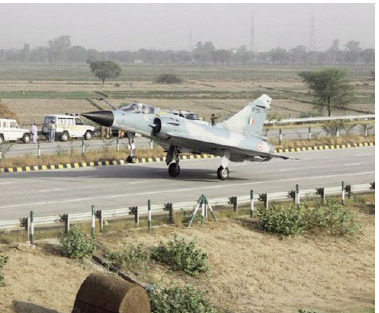 Matt Pottinger
India has been beefing up its
military muscle in the Chinaspecific
military theatre for years,
making it impossible for China to
repeat its shenanigans if 1962.
China knows that India has
actually beefed up its military
muscle in recent years like never
before. Here are a few examples.
= India plans to spend
about a billion dollars soon to
boost IAF's capabilities vis a vis
China in two ways immediately:
(1) by constructing 108 new
generation aircraft shelters to
protect its fighter fleet; and (2)
by improving the infrastructure
in Nyoma and Kargil airfields in
Ladakh to facilitate more
fighter flying near India's
border with China and
Pakistan.
= Essentially, it means India
is preparing its military
infrastructure and capabilities
to fight a two-pronged war
simultaneously with China and
Pakistan.
= The hardened blast panes
with reinforced concrete and
iron doors, each costing Rs 50
crores, will safeguard India's
frontline fighter aircraft like Su-
30MKI, Jaguars, Mirages and
the upcoming Rafale aircraft
from 2,000- pound enemy
bombs in case of a war. Iron
doors are meant to minimize
the chances of fragmentation
damage from a missile strike.
= Currently, IAF shelters are
capable of withstanding a blast
from a 1,000-pound bomb
whereas China already
possesses 2,000-pound bombs.
= India will spend two
billion dollars to upgrade 17
highways across the country
for aircraft landings, take-offs
of defence planes and rapid
deployment of security forces.
While being key force
multipliers in war conditions,
these highway airstrips will be
used for disaster management,
relief operations and casualty
evacuation in peace times.
Vehicular movement will be
suspended when an airplane
lands or takes off.
= The scheme was first
mooted in January 2016.
However, it was only a few days
ago that all clearances have
been given, coinciding with a
month-long Sikkim crisis, the
worst standoff between
Chinese and Indian militaries
since the 1962 Sino-Indian War.
= The highways to be
upgraded include Bijbehera-
Chinar Bagh, Banihal-Srinagar,
K h a r a g p u r - B a l a s o r e ,
Kharagpur-Keonjhar, Lucknow-
Agra Expressway, Phalodi-
Jaisalmer, Barmer-Jaisalmer,
Dwarka-Maliya, Nellore-
Ongole, Ongole-Chikaluripet,
C h e n n a i - P o n d i c h e r r y ,
Kodiakkarai-Ramanathpuram
and Lucknow Balia Expressway.
= Recently, the Indian Air
Force (IAF) successfully landed
a Mirage-2000 on the Yamuna
Expressway near Mathura as
part of its trials to use national
highways for emergency
landing by fighter aircraft.
= In Arunachal Pradesh,
Meghalaya and Rajasthan's
border districts, the upgraded
highways will be used as
airstrips as a greenfield airport
cannot be constructed there
due to several constraints.
Matt Pottinger
India has been beefing up its
military muscle in the Chinaspecific
military theatre for years,
making it impossible for China to
repeat its shenanigans if 1962.
China knows that India has
actually beefed up its military
muscle in recent years like never
before. Here are a few examples.
= India plans to spend
about a billion dollars soon to
boost IAF's capabilities vis a vis
China in two ways immediately:
(1) by constructing 108 new
generation aircraft shelters to
protect its fighter fleet; and (2)
by improving the infrastructure
in Nyoma and Kargil airfields in
Ladakh to facilitate more
fighter flying near India's
border with China and
Pakistan.
= Essentially, it means India
is preparing its military
infrastructure and capabilities
to fight a two-pronged war
simultaneously with China and
Pakistan.
= The hardened blast panes
with reinforced concrete and
iron doors, each costing Rs 50
crores, will safeguard India's
frontline fighter aircraft like Su-
30MKI, Jaguars, Mirages and
the upcoming Rafale aircraft
from 2,000- pound enemy
bombs in case of a war. Iron
doors are meant to minimize
the chances of fragmentation
damage from a missile strike.
= Currently, IAF shelters are
capable of withstanding a blast
from a 1,000-pound bomb
whereas China already
possesses 2,000-pound bombs.
= India will spend two
billion dollars to upgrade 17
highways across the country
for aircraft landings, take-offs
of defence planes and rapid
deployment of security forces.
While being key force
multipliers in war conditions,
these highway airstrips will be
used for disaster management,
relief operations and casualty
evacuation in peace times.
Vehicular movement will be
suspended when an airplane
lands or takes off.
= The scheme was first
mooted in January 2016.
However, it was only a few days
ago that all clearances have
been given, coinciding with a
month-long Sikkim crisis, the
worst standoff between
Chinese and Indian militaries
since the 1962 Sino-Indian War.
= The highways to be
upgraded include Bijbehera-
Chinar Bagh, Banihal-Srinagar,
K h a r a g p u r - B a l a s o r e ,
Kharagpur-Keonjhar, Lucknow-
Agra Expressway, Phalodi-
Jaisalmer, Barmer-Jaisalmer,
Dwarka-Maliya, Nellore-
Ongole, Ongole-Chikaluripet,
C h e n n a i - P o n d i c h e r r y ,
Kodiakkarai-Ramanathpuram
and Lucknow Balia Expressway.
= Recently, the Indian Air
Force (IAF) successfully landed
a Mirage-2000 on the Yamuna
Expressway near Mathura as
part of its trials to use national
highways for emergency
landing by fighter aircraft.
= In Arunachal Pradesh,
Meghalaya and Rajasthan's
border districts, the upgraded
highways will be used as
airstrips as a greenfield airport
cannot be constructed there
due to several constraints.




 Rajeev Sharma
Rajeev Sharma Illustrative diagram of the Doklam plateau at the India-China-Bhutan tri-junction in the Sikkim sector,
showing the relative positions of the Indian Army post at Doka La, the 20 km-long Chinese 'Class-5' track,
and the Jampheri ridge. The drawing is approximate, and not to scale. Sarfaraz Alam/Terrain Image from Google
Earth. Courtesy Indian Express
Illustrative diagram of the Doklam plateau at the India-China-Bhutan tri-junction in the Sikkim sector,
showing the relative positions of the Indian Army post at Doka La, the 20 km-long Chinese 'Class-5' track,
and the Jampheri ridge. The drawing is approximate, and not to scale. Sarfaraz Alam/Terrain Image from Google
Earth. Courtesy Indian Express Former Chinese Premier Wen
Jiabao with his Bhutanese
counterpart Jigmi Y. Thinley in
Rio de Janeiro.
Former Chinese Premier Wen
Jiabao with his Bhutanese
counterpart Jigmi Y. Thinley in
Rio de Janeiro. Xi Jinping
Xi Jinping The Dalai Lama wearing an
Assamese Japi during an event
in Guwahati.
The Dalai Lama wearing an
Assamese Japi during an event
in Guwahati. Masood Azhar
Masood Azhar Matt Pottinger
Matt Pottinger Matt Pottinger
Matt Pottinger